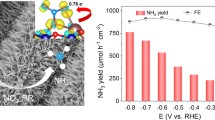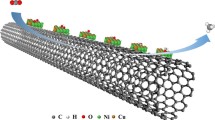Abstract
Pyrolyzed cobalt-nitrogen-carbon (Co–N-C) systems are considered as promising Pt-free electrocatalysts for oxygen reduction reaction (ORR) and hydrogen evolution reaction (HER). Here, we studied the possibility of using poly-5-aminoindole together with graphene oxide, multilayer graphene (MLG), or nitrogen-doped MLG (N-MLG) for the formation of Co–N-C electrocatalysts for both ORR and HER in acid electrolyte. Using 5-aminoindole with ammonium persulfate instead of pre-prepared polymer allows to simplify the synthesis of Co–N-C electrocatalysts, but causes the presence of Co9S8 particles in their composition. It was found that type of graphene-like precursor affects composition catalysts and the ratio of active sites, which leads to differences in their catalytic performance towards ORR and HER. The best efficiency of electrocatalyst derived from N-MLG for both ORR (onset potential of 795 mV, half-wave potential of 688 mV, and a Tafel slope of 73 mV/dec) and HER (overpotential of 207 mV at the current density of 10 mA/cm2, and a Tafel slope of 69 mV/dec) is largely attributed to the highest content of pyridinic nitrogen in its composition, which is responsible for the formation of CoNx active sites. The obtained results allow to conclude that the same active sites of the prepared catalysts are participate in both HER and ORR.
Graphical abstract










Similar content being viewed by others
References
Stamenkovic VR, Strmcnik D, Lopes PP, Markovic NM (2016) Energy and fuels from electrochemical interfaces. Nat Mater 16:57–69
Zhang J, Chen G, Müllen K, Feng X (2018) Carbon-rich nanomaterials: fascinating hydrogen and oxygen electrocatalysts. Adv Mater 30:1800528
Sealy C (2008) The problem with platinum. Mater Today 11:65–68
Gewirth AA, Varnell JA, Diascro AM (2018) Nonprecious metal catalysts for oxygen reduction in heterogeneous aqueous systems. Chem Rev 118:2313–2339
Chung HT, Cullen DA, Higgins D et al (2017) Direct atomic-level insight into the active sites of a high-performance PGM-free ORR catalyst. Science 357:479–484
Zhu YP, Guo C, Zheng Y, Qiao SZ (2017) Surface and interface engineering of noble-metal-free electrocatalysts for efficient energy conversion processes. Acc Chem Res 50:915–923
He Y, Tan Q, Lu L et al (2019) Metal-nitrogen-carbon catalysts for oxygen reduction in PEM fuel cells: self-template synthesis approach to enhancing catalytic activity and stability. Electrochem Energy Rev 2:231–251
Liu K, Zhong H, Meng F et al (2017) Recent advances in metal-nitrogen-carbon catalysts for electrochemical water splitting. Mater Chem Front 1:2155–2173
Zhang L, Liu W, Dou Y et al (2016) The role of transition metal and nitrogen in metal-N-C composites for hydrogen evolution reaction at universal pHs. J Phys Chem C 120:29047–29053
Wu G, More KL, Johnston CM, Zelenay P (2011) High-performance electrocatalysts for oxygen reduction derived from polyaniline, iron, and cobalt. Science 332:443–447
Kurys YI, Ustavytska OO, Koshechko VG, Pokhodenko VD (2016) Structure and electrochemical properties of multilayer graphene prepared by electrochemical exfoliation of graphite in the presence of benzoate ions. RSC Adv 6:36050–36057
Ustavytska O, Kurys Y, Koshechko V, Pokhodenko V (2017) One-step electrochemical preparation of multilayer graphene functionalized with nitrogen. Nanoscale Res Lett 12:175
Higgins D, Zamani P, Yu A, Chen Z (2016) The application of graphene and its composites in oxygen reduction electrocatalysis: a perspective and review of recent progress. Energy Environ Sci 9:357–390
Kovtyukhova NI (1999) Layer-by-layer assembly of ultrathin composite films from micron-sized graphite oxide sheets and polycations. Chem Mater 11:771–778
Pariiska OO, Mazur DO, Kurys YI et al (2019) Effect of the formation conditions on the activity of Co-N-C electrocatalysts derived from poly-m-phenylenediamine in the reduction of oxygen. Theor Exp Chem 54:386–394
Tanuma S, Powell CJ, Penn DR (1994) Calculations of electron inelastic mean free paths. V. Data for 14 organic compounds over the 50–2000 eV range. Surf Interface Anal 21:165–176
Wu G, Mack NH, Gao W et al (2012) Nitrogen-doped graphene-rich catalysts derived from heteroatom polymers for oxygen reduction in nonaqueous lithium–O2 battery cathodes. ACS Nano 6:9764–9776
Wu G, Chung HT, Nelson M et al (2011) Graphene-riched Co9S8-NC non-precious metal catalyst for oxygen reduction in alkaline media. ECS Trans 41:1709
Wu G, Johnston CM, MacK NH et al (2011) Synthesis-structure-performance correlation for polyaniline-Me-C non-precious metal cathode catalysts for oxygen reduction in fuel cells. J Mater Chem 21:11392–11405
Zhu Y, Zhang B, Liu X et al (2014) Unravelling the structure of electrocatalytically active Fe–N complexes in carbon for the oxygen reduction reaction. Angew Chemie 126:10849–10853
Dongjiang Z, Songyan M, Geping Y (2017) A facile one-step synthesis of Co9S8 electrocatalyst for oxygen reduction reaction. Rare Metal Mat Eng 46:3577–3582
Dou S, Tao L, Huo J et al (2016) Etched and doped Co9S8/graphene hybrid for oxygen electrocatalysis. Energy Environ Sci 9:1320–1326
Wu C, Zhang Y, Dong D et al (2017) Co9S8 nanoparticles anchored on nitrogen and sulfur dual-doped carbon nanosheets as highly efficient bifunctional electrocatalyst for oxygen evolution and reduction reactions. Nanoscale 9:12432–12440
Tran TN, Song MY, Singh KP et al (2016) Iron-polypyrrole electrocatalyst with remarkable activity and stability for ORR in both alkaline and acidic conditions: a comprehensive assessment of catalyst preparation sequence. J Mater Chem A 4:8645–8657
Jiang S, Zhu C, Dong S (2013) Cobalt and nitrogen-cofunctionalized graphene as a durable non-precious metal catalyst with enhanced ORR activity. J Mater Chem A 1:3593–3599
Lee K, Zhang L, Lui H et al (2009) Oxygen reduction reaction (ORR) catalyzed by carbon-supported cobalt polypyrrole (Co-PPy/C) electrocatalysts. Electrochim Acta 54:4704–4711
Wu G, Chen Z, Artyushkova K, Garzon FH, Zelenay P (2008) Polyaniline-derived non-precious catalyst for the polymer electrolyte fuel cell cathode. ECS Trans 16:159
Huang S, Meng Y, He S et al (2017) N-, O-, and S-tridoped carbon-encapsulated Co9S8 nanomaterials: efficient bifunctional electrocatalysts for overall water splitting. Adv Funct Mater 27:1606585
Campos-Delgado J, Maciel IO, Cullen DA et al (2010) Chemical vapor deposition synthesis of N-, P-, and Si-doped single-walled carbon nanotubes. ACS Nano 4:1696–1702
Fu X, Liu Y, Cao X et al (2013) FeCo-Nx embedded graphene as high performance catalysts for oxygen reduction reaction. Appl Catal B Environ 130–131:143–151
Choi WI, Jhi SH, Kim K, Kim YH (2010) Divacancy-nitrogen-assisted transition metal dispersion and hydrogen adsorption in defective graphene: a first-principles study. Phys Rev B - Condens Matter Mater Phys 81:085441
Sun T, Wu Q, Jiang Y et al (2016) Sulfur and nitrogen codoped carbon tubes as bifunctional metal-free electrocatalysts for oxygen reduction and hydrogen evolution in acidic media. Chem - A Eur J 22:10326–10329
Alstrup I, Chorkendorff I, Candia R et al (1982) A combined X-Ray photoelectron and Mössbauer emission spectroscopy study of the state of cobalt in sulfided, supported, and unsupported CoMo catalysts. J Catal 77:397–409
Carver JC, Schweitzer GK, Carlson TA (1972) Use of X-ray photoelectron spectroscopy to study bonding in Cr, Mn, Fe, and Co compounds. J Chem Phys 57:973–982
Baez VB, Pletcher D (1995) Preparation and characterization of carbon/titanium dioxide surfaces—the reduction of oxygen. J Electroanal Chem 382:59–64
Hou Y, Wen Z, Cui S et al (2015) An advanced nitrogen-doped graphene/cobalt-embedded porous carbon polyhedron hybrid for efficient catalysis of oxygen reduction and water splitting. Adv Funct Mater 25:872–882
Acknowledgements
O. Pariiska and D. Mazur acknowledge the CERIC-ERIC Consortium for access to experimental facilities at field emission scanning electron microscope at the Charles University in Prague and financial support under proposal 20192057.
Funding
This work was partially supported by the targeted programs of scientific research of the National Academy of Sciences of Ukraine “Development of scientific bases for hydrogen production, storage and use in autonomous energy supply systems” (project no. 19) and “New functional substances and materials for chemical industry” (project no. 1) as well as by the grant from the Polish Academy of Sciences for the internship of young scientists (O. Pariiska) at the Jerzy Haber Institute of Catalysis and Physical and Surface Chemistry.
Author information
Authors and Affiliations
Corresponding author
Ethics declarations
Conflicts of interest
The authors declare no competing interests.
Supplementary information
Below is the link to the electronic supplementary material.
Rights and permissions
About this article
Cite this article
Pariiska, O., Mazur, D., Kurys, Y. et al. Poly-5-aminoindole and graphene-like materials derived bifunctional Co–N-C electrocatalysts for oxygen reduction and hydrogen evolution. J Solid State Electrochem 25, 2309–2319 (2021). https://doi.org/10.1007/s10008-021-05009-6
Received:
Revised:
Accepted:
Published:
Issue Date:
DOI: https://doi.org/10.1007/s10008-021-05009-6




